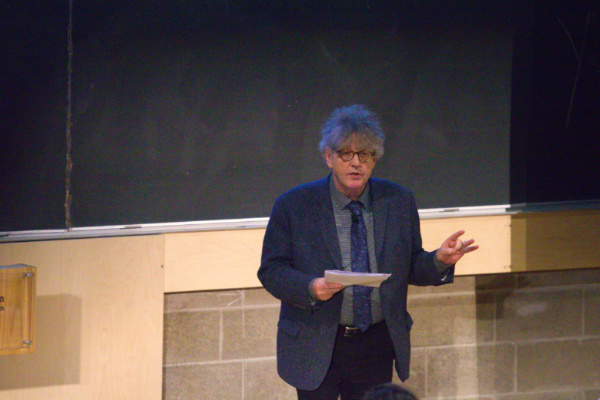
Northern Irish poet Paul Muldoon seemed well acquainted with the stage as he gave this year’s Edmund Burke lecture, entitled “He Who Did Nothing: The Poet as Citizen”. Muldoon eased himself into the precarious lecture topics he had chosen for the evening by humorously recounting his introduction to Trinity: “I’m pretty sure the first time I heard of Trinity College Dublin per se was in 1968, when I wondered if I’d be eligible to attend. This of course was still the era when the Catholic Church banned Catholics from attending the college. There was a palpably odd concern that Catholics would somehow lose their faith if they were exposed to Protestants. What a faith.”
But Muldoon’s lecture did far more than probe the obsolete views of the Catholic Church. He warned the audience that he wanted to discuss “a range of vexing topics”, apologising: “I know you were expecting a fun night out.” He then firmly planted himself in “tricky and treacherous ground”, making clear his intention to focus mainly on cultural appropriation and the duties and rights of the artist.
Muldoon first appealed to Edmund Burke, and his idea that “language is the eye of society”. He then addressed his use of certain weighty words in his poetry. He opined: “Language, because of society, is changing all the time. Think of the word ‘negro’ in ‘My Father and I’ and ‘Billy Two Rivers’. It was a word that had some currency in the 1960s just as it had in 1792, when Burke developed his admirably judged ‘Sketch of a Negro Code’.” Muldoon continued: “I can see how some readers in this hypersensitive era might suggest that my use of the word in that poem is still in some sense inappropriate. I suggest it’s very much of its time, not that that cures all illnesses.”
Muldoon’s use of the word “hypersensitive” came across as quite tactless, particularly considering his audience, and given the lambasting in some sections of society of movements such as #MeToo and #BlackLivesMatter. But perhaps that is just a hypersensitive millennial talking.
While Muldoon avoided giving an explicit insight into his opinion of political correctness, he was direct when expressing his contempt for those who use strong allusive words with mal-intent. He derided Donald Trump’s use of inappropriate and repulsive language, emphasising how frail the barriers of language have become in modern times. Quoting George Washington’s rules for civility, he appealed to the audience to “keep alive in your breast that little spark of celestial fire called conscience”.
Muldoon argued that unlike Trump, whose language is infused with hatred, many artists have been wrongfully accused of racism in their depictions of black characters. When The Nation magazine published a poem by Anders Carlson-Wee this year, it sparked outrage due to the white poet’s use of black vernacular. The Nation issued an apology and Carlson-Wee also apologised, saying: “Threading anywhere close to blackface is horrifying to me and I am profoundly regretful.” But this apology was to the magazine’s detriment as it was conceding to the idea that white artists should not depict black characters, which traps the artist within the realm of their own race and culture. Muldoon asserted: “Whatever else this poem is, it’s not blackface, it’s a dramatisation of a character. It’s time someone stepped up and said that.”
What, then, are an artist’s boundaries, if they act with good intentions? According to Muldoon, there are none: “I tend to be on the same page as my colleague, Toni Morrison, who responded to a Paris review question about William Styron’s right to write the first-person voice of a slave in his 1967 novel The Confessions of Nat Turner. Toni Morrison responded: ‘He has the right to write about whatever he wants. To suggest otherwise is outrageous.’”
Muldoon cut into the issue of political correctness with a blunt knife. His lecture was indisputably necessary, addressing as it did the waning possibility of appreciating and convoking different races and cultures in art. Yet eliding his opinion on political correctness was a perilous move as it allowed the audience to guess what he believes are the limits of cultural appreciation.
While referring to Carlson-Wee’s poem in The Nation magazine, Muldoon made a strong point that “the right to tell black people’s stories, along with the right to tell stories in general, is under threat”. However, Muldoon’s reverence for the artist dismisses the right of an audience to react to art. Ultimately, it is the reader or audience member who decides what they find offensive, especially when their culture or race is being dramatised. Artists are not unassailable and while white artists should not be criticised for creating black characters, the artist should not decide the point at which cultural appreciation becomes cultural appropriation.
Muldoon ended his lecture talking about his appreciation of Van Morrison, whose music encompasses many genres including soul and jazz, despite being a white man from Belfast. Muldoon concluded: “A few reasons why Van Morrison has had such a remarkable career is that he has done everything but stay in his own lane. He is the very essence of non-essentialism. Nor has he stolen anything, he has been stolen by something. Nor does he own anything, he is owned by something.”






